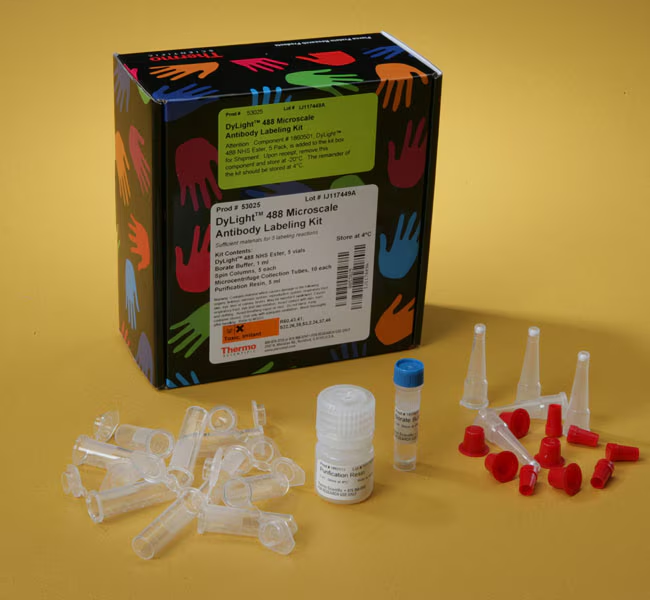DyLight™ Microscale Antibody Labeling Kits (Thermo Scientific™)
Invitrogen Dylight Microscale Antibody Labeling kits provide everything needed to label 100 μg of antibody or protein with amine-reactive Dylight dye and subsequent free dye removal. Choose from a variety of Dylight fluorophores across the spectrum to covalently label your antibody or protein. Labeled antibodies are typically ready to use in 90 minutes with minimal hands-on time. The kit contains all necessary components to perform five separate labeling reactions using 100 μg of IgG or similar quantities of other proteins. Labeled antibody or protein can be used for a variety of applications including immunofluorescence microscopy, flow cytometry, IHC, western blotting, or ELISA.
Key Features
Invitrogen DyLight Antibody Labeling kits enable the creation of fluorescent antibodies that are covalently linked to different DyLight fluorophores. The fluorescently labeled antibodies can be used in a wide variety of laboratory applications, including immunofluorescence microscopy, IHC, western blotting, ELISA, flow cytometry, or in vitro and in vivo fluorescent detection strategies.
DyLight Antibody Labeling kits contain an NHS ester-activated derivative of the high-performance DyLight dye that can be used to fluorescently label antibodies and other proteins for cellular imaging and other fluorescence detection methods. The DyLight dye is an amine-reactive dye and is activated with an N-hydroxysuccinimide (NHS) ester moiety to react with exposed N-terminal α-amino groups or the ε-amino groups of lysine residues to form stable amide bonds. DyLight Antibody Labeling kits contain all necessary components to perform three separate labeling reactions and free dye removal using 100 μg of IgG or similar quantities of other proteins.
DyLight dyes exhibit higher fluorescence intensity and photostability than CyDye and LI-COR™ dyes in many applications and remain highly fluorescent over a broad pH range (pH 4–9). Additionally, the water solubility of the DyLight fluorescent dyes allows a high dye-to-protein ratio to be achieved without causing precipitation of conjugates. Finally, the high solubility of these fluorophores permits protein solutions to be added directly to specific amounts of the labeling reagent.
Other advantages of DyLight Antibody Labeling kits:
· High performance—high fluorescence intensity across a broad pH range
· Multiple colors—10 different dyes across the visible spectrum and extending into the infrared
· Specificity—NHS ester-activated dye labels proteins and other molecules at primary amines (-NH2)
· Optimized procedure—following the standard protocol results in antibodies with excellent dye:protein ratios and recovery rates for optimum activity and fluorescence labeling
We also offer DyLight Antibody Labeling kits for fast and efficient fluorescent labeling of antibodies for use in fluorescence methods. DyLight Antibody Labeling kits contain all necessary components to perform three separate labeling reactions using 1 mg of IgG or similar quantities of other proteins. Both the standard and microscale kit sizes include the amine-reactive DyLight fluorophore in convenient single-use vials as well as purification resin and spin columns for the preparation of ready-to-use conjugate.
Order Codes
| Code |
Description |
| 84539 |
Catalog Number: 84539
Unit Size: 5 reactions
Excitation/Emission: 749/775
Label or Dye: DyLight 755 |
| 53021 |
Catalog Number: 53021
Unit Size: 5 reactions
Excitation/Emission: 401/421
Label or Dye: DyLight 405 |
| 53025 |
Catalog Number: 53025
Unit Size: 5 reactions
Excitation/Emission: 490/525
Label or Dye: DyLight 488 |
| 53045 |
Catalog Number: 53045
Unit Size: 5 reactions
Excitation/Emission: 590/617
Label or Dye: DyLight 594 |
| 53063 |
Catalog Number: 53063
Unit Size: 5 reactions
Excitation/Emission: 784/814
Label or Dye: DyLight 800 |
| 84531 |
Catalog Number: 84531
Unit Size: 5 reactions
Excitation/Emission: 562/576
Label or Dye: DyLight 550 |
| 84536 |
Catalog Number: 84536
Unit Size: 5 reactions
Excitation/Emission: 652/672
Label or Dye: DyLight 650 |


